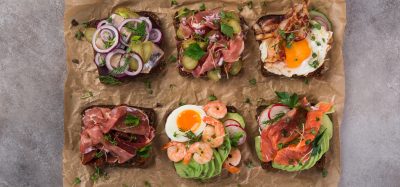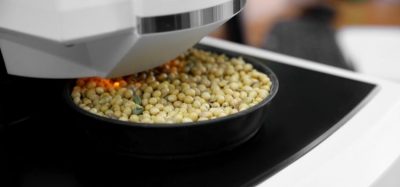Measurement of water dynamics by low-field NMR
- Like
- Digg
- Del
- Tumblr
- VKontakte
- Buffer
- Love This
- Odnoklassniki
- Meneame
- Blogger
- Amazon
- Yahoo Mail
- Gmail
- AOL
- Newsvine
- HackerNews
- Evernote
- MySpace
- Mail.ru
- Viadeo
- Line
- Comments
- Yummly
- SMS
- Viber
- Telegram
- Subscribe
- Skype
- Facebook Messenger
- Kakao
- LiveJournal
- Yammer
- Edgar
- Fintel
- Mix
- Instapaper
- Copy Link
Posted: 18 August 2008 | Dr Hanne Christine Bertram. Senior Project Scientist, University of Aarhus | No comments yet
Water is a major constituent in many foods. For example, in several of our basic food items such as muscle-based foods and vegetables, water is the dominating component and is in many ways of primary importance for the quality of these products. Low-field proton NMR relaxometry is an excellent technique for studying water properties in […]
Water is a major constituent in many foods. For example, in several of our basic food items such as muscle-based foods and vegetables, water is the dominating component and is in many ways of primary importance for the quality of these products. Low-field proton NMR relaxometry is an excellent technique for studying water properties in complex systems such as food.
Meat contains approximately 75 per cent water. Water is of fundamental significance for the quality of meat as it determines economic yield, sensory properties and shelf-life. Indeed, it is not possible to mention a quality parameter in meat which does not involve water, and accordingly, measuring the properties of the water in the meat is substantial. First, it is important to be able to determine the ability of meat to retain water, i.e. water-holding capacity (WHC) for a characterisation and grading according to meat quality. WHC of fresh meat is conventionally determined by simple gravimetric methods, which are both time-consuming and destructive. Accordingly, alternative and speedier methods are desired. In the search for new methods for determination of WHC, NMR has been suggested.
An NMR method has important advantages as it is a non-destructive method and it enables quick measurements. It has been established that low-field proton NMR relaxometry is an excellent technique for determining the WHC in a wide range of pork quality (Bertram et al., 2002). Figure 1 shows WHC determined by low-field NMR together with values determined by a gravimetric reference method. As the results show, the low-field NMR method is equally as good as the best reference method. The reason that the low-field NMR is an outstanding technique for determining WHC can be ascribed to the fact that the technique provides information about the distribution of water within the investigated matrix. As depicted in Figure 2, the method reveals the presence of three different water populations in meat, which can be ascribed to water in the hydration shell of the proteins, water located within the meat protein matrix and held by capillary forces, and water located in extramyofibrillar spaces respectively (Bertram et al., 2001).
Dynamic measurements
A major advantage of NMR is that it is a non-destructive technique. This implies that repeated measurements on the exact same sample are possible over a time period. Food manufacturing typically involves dynamic processes and therefore this possibility for dynamic measurements makes the NMR technique exceptional. Some of the dynamic processes we have studied by low-field NMR relaxometry include the conversion of muscle to meat, cooking, chilling, freezing and salting of various foods, including meat, potatoes and dairy products. Figure 3 shows examples of such dynamic measurements where changes in water distribution as a function of temperature and time have been followed by low-field proton NMR relaxometry. These studies have been able to establish during cooking at what temperatures severe changes take place in the water distribution, and thereby which changes influence the formation of cooking loss (Bertram et al., 2006). Also, in relation to understanding the earliest initial events taking place in muscles after slaughter when these are converted to meat, and which are decisive for the subsequent meat quality development, the technique has contributed extensively to the existing knowledge. While it has been a generally accepted theory that a redistribution of water is taking place in the muscles during this period, methods that could verify this have been absent. However, through low-field proton NMR relaxation measurements it has been possible to demonstrate that this actually occurs, and that the amount of water being expelled from the myofibrillar spaces during this period determines the final water-holding capacity of the meat (Bertram et al., 2004). While it is water that is under investigation in NMR relaxation studies on muscles and meat, the method can also provide information about other components in a food matrix. As an example, it has been demonstrated that during the chilling of cream, the crystallisation of lipids can be determined by dynamic low-field proton NMR relaxation measurements (Bertram et al., 2005).
Understanding the entire matrix
The characteristics of the water in food are largely determined by the other constituents present in the food matrix. In fact, capillary forces together with interactions between the water molecules and the surrounding macromolecules determine how tightly the water is being held. This means that for investigating the mechanisms determining water mobility and distribution, one can benefit from studying the behaviour of the macromolecules and the behaviour of the water simultaneously. The introduction of multivariate data analysis into food science has made multi-technique approaches more feasible, which enables the study of more features at the same time. In order to elucidate the simultaneous heat-induced changes in protein denaturation and changes in water mobility and distribution, differential scanning calorimetric (DSC) and low-field NMR measurements have been applied at the same time on meat samples cooked to various temperatures. While the DSC measurements provide information about the protein denaturation as a function of temperature, the low-field NMR measurements provide information about the water mobility and distribution as a function of cooking temperature. Consequently, by linking the two techniques we can understand how the protein denaturation taking place during cooking affects the inherent characteristics of the water and thereby the ability of the meat to retain water. In a similar way, low-field NMR measurements have been combined with simultaneous FT-IR spectroscopic measurements on meat in collaboration between researchers from the University of Aarhus in Denmark and researchers from Matforsk in Norway. FT-IR spectroscopy provides information about the specific protein secondary structures, and by combining NMR and FT-IR spectroscopy, the relationship between protein structure and water mobility and distribution could be studied in detail.
Quality AND microbial stability/safety in one measure?
Not only are the qualities of foods affected by water properties, the microbial stability and safety of foods are also determined by the water availability. What low-field proton NMR in fact measures is interactions between the water molecules and the other components present in the food matrix. These interactions are the reason that traditional water activity measurements sometimes fail to give a good measure of the microbial stability and safety, because these vapour pressure measurements do not take into account the structure and the heterogeneity of the food matrix. In contrast, low-field proton NMR measurements contain essential information about food microstructure and pore size distribution. Consequently, the method can be expected to give a good measure of water availability, and in a new Danish research project (‘Integrated characterisation of quality and microbial safety of foods,’ running between 2008 and 2011 and funded by The Danish Ministry of Food, Agriculture and Fisheries), the ability of low-field proton NMR to determine the microbial stability and safety of foods will be investigated. The project will include studies on model systems like protein and polysaccharide gels with well-characterised structural features, which makes a detailed investigation of the relationship between structure and water mobility and distribution possible. Moreover, various foods including both dairy and meat products will be included in the research project joining food researchers, microbiologists and industrial partners. The investigated foods will be inoculated with pathogenic bacteria, and low-field proton NMR measurements will be correlated to quantitative microbial investigations to evaluate if low-field proton NMR can predict both the quality and the microbial stability and safety of foods in one step.
Potentials for on-line measurements
Low-field proton NMR relaxometry is typically carried out on samples inserted into a sample tube with a diameter in the range of 14 to 20 millimetres using benchtop-equipment (Figure 4). In this way, the method is invasive and online measurements are not possible. However, mobile surface devices have been developed, which are used for the study of packaged model food emulsions (Haiduc et al., 2007) and bottled beverages (Stork et al., 2007). Moreover, effort is currently being put into developing potential online applications. Solving the problems involved in the development of novel NMR hardware for carrying out rapid measurements on a moving belt presents a true challenge. An English research group, with Professor Brian Hills leading the group, has developed and patented potential solutions (Hills et al., 2007), and it will be exciting to follow the development of these approaches in future.








References
Bertram, H.C., Karlsson A.H., Rasmussen, M., Dønstrup, S., Petersen, O.D. & Andersen, H.J., (2001). Origin of multii-exponential T2 Relaxation in Muscle Myowater. Journal of Agricultural and Food Chemistry, 49, 3092-3100.
Bertram, H.C., Dønstrup, S., Karlsson, A.H. & Andersen, H.J. (2002). Continuous distribution analysis of T2 relaxation in meat – An approach in the determination of water holding capacity. Meat Science 60, 279-285.
Bertram, H.C., Schäfer, A., Rosenvold, K. & Andersen, H.J., 2004. Physical changes of significance for early post mortem water distribution in porcine M. longissimus. Meat Science, 66, 915-924.
Bertram, H.C, Wiking, L., Nielsen, J.H. & Andersen, H.J. (2005). Direct measurement of phase transitions in milk fat during cooling of cream – A low-field NMR approach. International Dairy Journal, 15, 1056-1063.
Bertram, H.C., Wu, Z., van den Berg, F. & Andersen, H.J. (2006). NMR relaxometry and differential scanning calorimetry during meat cooking. Meat Science, 74, 684-689.
Haiduc, A.M.; Trezza, E.E., van Dusschoten, D., Reszka, A.A & van Duynhoven, J.P.M. (2007). Non-invasive ‘through-package’ assessment of the microstructural quality of a model food emulsion by the NMR MOUSE. LWT- Food Science and Technology, 40, 737-743.
Hills, B.; Wright, N.; Marigheto, N.; Hibberd, D. (2007): “Motional relativity and novel nmr sensors”. In: Magnetic Resonance in Food Science. Ed. I.A. Farhat, P.S. Belton and G.A. Webb. Royal Society of Chemistry, Cambridge, 2007.
Stork, H.; Gadke, A. & Nestle, N. (2007): Single-sided and semisingle-sided NMR sensors for highly diffusive samples: Application to bottled beverages. Journal of Agricultural and Food Chemistry, 54, 5247-5252.









